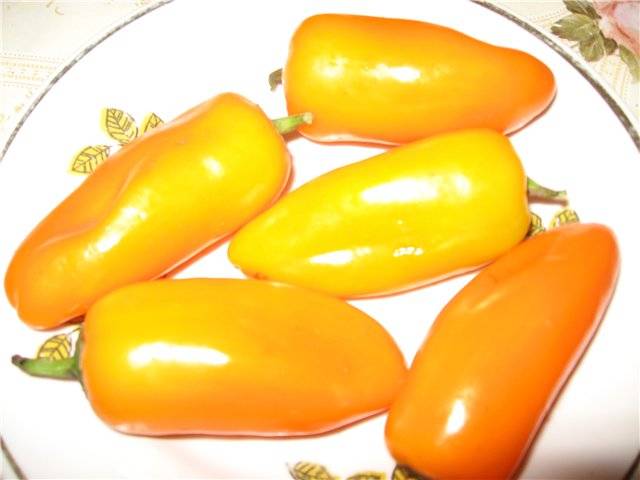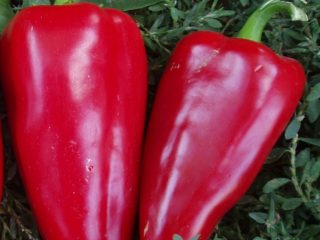Content
Orange is not only a citrus fruit, but also the name of a variety of sweet bell peppers. The uniqueness of “exotic” vegetables lies not only in the name, but also in the amazing taste, which is comparable to a fruit delicacy. Orange pepper is distinguished by its special sweetness and aroma, which is why it is considered a delicacy. The variety is zoned for the central region of Russia and is available for cultivation to every gardener. A detailed description of the agrotechnical and taste characteristics of peppers of this unique variety is given below.
Description
The Orange variety is represented by red and yellow peppers. The size of the fruit is small - each cylindrical vegetable is up to 10 cm long, its average weight is 40 g. The thickness of the pepper walls is small - up to 5 mm. The surface of the vegetable is smooth, glossy, the color is bright, the skin is especially thin and delicate. You can see the “Orange” pepper in the photo below:
The peculiarity of the Orange variety lies, first of all, in its unique taste and aroma. The pulp of the vegetable contains a large amount of sugar, vitamin C, carotene and other microelements, the complex of which allows us to consider the variety the most delicious, sweet and at the same time surprisingly healthy. The fruits are consumed fresh, and are also used for preparing culinary dishes and winter preparations.The absence of excess moisture in the pulp of the Orange pepper allows it to be dried in the form of small pieces, thereby obtaining tasty, sweet candied fruits - a healthy delicacy for adults and children.
Agrotechnical characteristics of the variety
The producer of seeds of the “Orange” variety is the domestic seed-growing company “Russian Garden”. The breeders of this company have developed numerous well-known varieties of vegetable crops, among which, undoubtedly, “Orange” should be included.
Peppers of the "Orange" variety are grown in the middle and northwestern latitudes in open areas, in greenhouses, and greenhouses. In this case, as a rule, the seedling method of cultivation is used.
The bushes of the "Orange" plant are compact, up to 40 cm high, which allows them to be planted quite densely - 5 bushes per 1 m2 soil. The period of fruit ripening from the day of sowing the seeds is 95-110 days.
Another feature of the Orange variety is its high yield. During the period of active fruiting, the bushes are abundantly strewn with small peppers in the amount of 25-35 pieces. The total yield of the variety is high and reaches 7 kg/m2. It should be borne in mind that when grown in protected conditions, this figure can be significantly increased.
Basic stages and rules for growing pepper
To get a rich harvest of delicious vegetables, it is not enough to simply purchase seeds. They must be sown in compliance with certain rules, within the established time limits, and subsequently provide proper care for the plants. Moreover, each variety of pepper has its own cultivation characteristics. Thus, growing “Orange” peppers consists of the following stages:
Sowing seeds for seedlings
Sowing seeds for seedlings must be done in the first ten days of February (for subsequent planting of plants in a greenhouse or greenhouse) or in mid-March (for planting in open ground). To grow seedlings, you can use ready-made soil mixtures or prepare the soil yourself by mixing garden soil with peat, humus, and sand. You can use small plastic cups or peat pots as a container for cultivation.
Before sowing in the ground, the seeds of the “Orange” pepper must be germinated. To do this, they should be placed in conditions with high humidity and a temperature of +270C. In such a microclimate, the seeds will hatch in 5-10 days. Plant the germinated seeds into the prepared soil to a depth of 0.5-1 mm.
The optimal length of the photoperiod for favorable seedling growth is 12 hours, which means that natural daylight in winter is not enough for young plants. You can create favorable conditions for seedlings by placing reflective materials around the perimeter of containers with crops and installing fluorescent lamps.
You need to feed the seedlings once every 2 weeks. Complex formulations should be used as fertilizer, for example “Kornevin”, “Florist Rost”, “Nitrofoska” and others. The optimal temperature for growing seedlings of "Orange" peppers is considered to be + 22-+230WITH.
Planting young plants
It is necessary to plant seedlings of the “Orange” variety at the age of 45-50 days. Two weeks before this, the plants need to start hardening off, periodically taking them outside.The length of time plants stay in unprotected conditions should be gradually increased from half an hour to a full day of daylight. This will allow you to smoothly prepare the plants for outdoor temperature conditions and exposure to direct sunlight.
The soil for cultivating peppers should be loose and nutritious. Its composition must include peat, compost, sawdust treated with urea, and sand. If desired, you can add a hydrogel to the soil, which will retain moisture in the soil. This filler is added at the rate of 1 g per 1 liter of soil.
It is necessary to plant seedlings in previously prepared, abundantly moistened holes. You should remove the plant from the container with extreme caution, preserving the earthen lump and without injuring the root system. Peat pots are embedded in the ground along with the plant for subsequent decomposition. After uniform compaction of the soil, young plants are watered and tied to a trellis.
Daily crop care
It is necessary to take care of the formation of the bush immediately after the plant has taken root. The top of the main stem is removed (pinched), which provokes intensive growth of lateral fruiting shoots. There should be no more than 5 of them. Smaller shoots must be removed (stepchildren).
Mandatory procedures when growing peppers are watering, weeding, loosening, and fertilizing:
- Peppers need to be watered generously (more than 10 liters of water per 1 m2 soil) 2-3 times a week;
- Loosening and weeding are usually carried out simultaneously. The event allows you to improve the nutrition and respiration of the plant’s root system;
- To feed peppers, you can use an infusion of cow or chicken droppings, a herbal infusion, or special complex fertilizers containing nitrogen, potassium, and phosphorus.
In addition to these standard measures, it is recommended to provide:
- Mulching will help curb the growth of weeds and prevent the soil from drying out;
- Additional (artificial) pollination is carried out during the flowering period of peppers by lightly shaking the branches of the bush. This will allow the plant to abundantly form even, beautiful peppers.
“Orange” is one of the best varieties of pepper, ideally suited for cultivation in domestic climatic conditions. It is grown by professional farmers and beginning gardeners. The vegetable deserves special attention due to its excellent sweet taste and bright aroma. High yield is also an undeniable advantage of the Orange variety.














